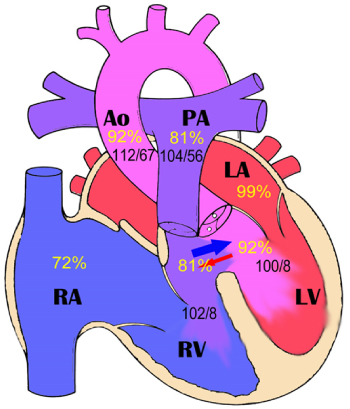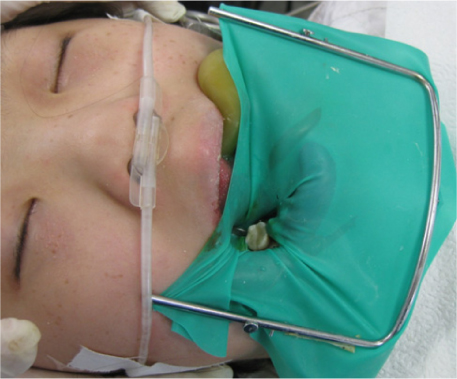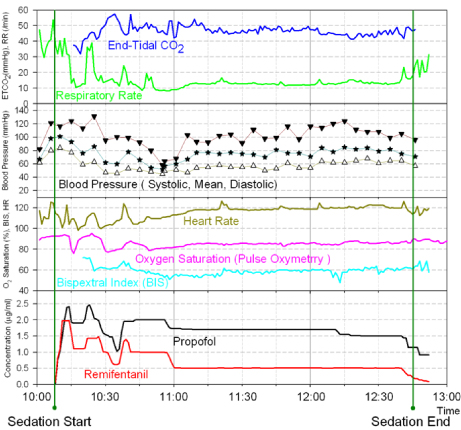J Dent Anesth Pain Med.
2016 Mar;16(1):67-71. 10.17245/jdapm.2016.16.1.67.
Deep sedation for dental treatment in a Down syndrome patient with Eisenmenger syndrome: A case report
- Affiliations
-
- 1Department of Dental Anesthesiology, School of Dentistry, Seoul National University, Seoul, Korea. stone90@snu.ac.kr
- KMID: 2308768
- DOI: http://doi.org/10.17245/jdapm.2016.16.1.67
Abstract
- Eisenmenger syndrome (ES) is characterized by pulmonary arterial hypertension and right-to-left shunting. The signs and symptoms of ES include cyanosis, shortness of breath, fatigue, hemoptysis, and sudden death. In patients with ES, it is important that the systemic and pulmonary circulations be properly distributed and maintained. General dental treatment is not known to be particularly dangerous. To control pain and anxiety, local anesthetics without epinephrine are usually recommended. However, in cases of difficulty of cooperation, general anesthesia for dental treatment makes the condition worse. In the present case, intravenous deep sedation with propofol and remifentanil was administered for behavioral management during dental treatment successfully.
Keyword
MeSH Terms
Figure
Reference
-
1. Hopkins WE. Severe pulmonary hypertension in congenital heart disease: A review of eisenmenger syndrome. Curr Opin Cardiol. 1995; 10:517–523.2. Raines DE, Liberthson RR, Murray JR. Anesthetic management and outcome following noncardiac surgery in nonparturients with eisenmenger's physiology. J Clin Anesth. 1996; 8:341–347.
Article3. Kunimatsu T, Greenan S, Yamashita A, Yamamoto T, Ikeda M. Use of moderate sedation for a patient with down syndrome, intellectual disability, and eisenmenger syndrome: A case report. Spec Care Dentist. 2011; 31:41–43.
Article4. Pastore E, Marino B, Calzolari A, Digilio MC, Giannotti A, Turchetta A. Clinical and cardiorespiratory assessment in children with down syndrome without congenital heart disease. Arch Pediatr Adolesc Med. 2000; 154:408–410.
Article5. Oechslin E, Mebus S, Schulze-Neick I, Niwa K, Trindade PT, Eicken A, et al. The adult patient with eisenmenger syndrome: A medical update after dana point part iii: Specific management and surgical aspects. Curr Cardiol Rev. 2010; 6:363–372.
Article6. Somerville J. How to manage the eisenmenger syndrome. Int J Cardiol. 1998; 63:1–8.
Article7. Daliento L, Somerville J, Presbitero P, Menti L, Brach-Prever S, Rizzoli G, et al. Eisenmenger syndrome. Factors relating to deterioration and death. Eur Heart J. 1998; 19:1845–1855.
Article8. Bennett JM, Ehrenfeld JM, Markham L, Eagle SS. Anesthetic management and outcomes for patients with pulmonary hypertension and intracardiac shunts and eisenmenger syndrome: A review of institutional experience. J Clin Anesth. 2014; 26:286–293.
Article9. Galie N, Manes A, Palazzini M, Negro L, Marinelli A, Gambetti S, et al. Management of pulmonary arterial hypertension associated with congenital systemic-to-pulmonary shunts and eisenmenger's syndrome. Drugs. 2008; 68:1049–1066.
Article10. Wilson W, Taubert KA, Gewitz M, Lockhart PB, Baddour LM, Levison M, et al. Guidelines from the american heart association: A guideline from the american heart association rheumatic fever, endocarditis and kawasaki disease committee, council on cardiovascular disease in the young, and the council on clinical cardiology, council on cardiovascular surgery and anesthesia, and the quality of care and outcomes research interdisciplinary working group. J Am Dent Assoc. 2007; 138:739–745. 747–760.11. Lumley J, Whitwam JG, Morgan M. General anesthesia in the presence of eisenmenger's syndrome. Anesth Analg. 1977; 56:543–547.
Article12. Manley MC, Skelly AM, Hamilton AG. Dental treatment for people with challenging behaviour: General anaesthesia or sedation? Br Dent J. 2000; 188:358–360.
Article13. Schwilden H, Schuttler J. Target controlled anaesthetic drug dosing. Handb Exp Pharmacol. 2008; 425–450.
Article14. Lee BS, Shin TJ, Kim HJ, Choi YJ, Lee SE, Chang JH, et al. Effect site concentrations of propofol for dental treatment under deep sedation in intellectually disabled patients. J Korean Dent Soc Anesthesiol. 2014; 14:167–172.
Article15. Kiyama S, Yoshikawa T. Target-controlled infusion of propofol for the difficult airway. Anaesth Intensive Care. 1998; 26:591–592.16. Sung J, Kim HJ, Choi YJ, Lee SE, Seo KS. Comparison of efficacy of propofol when used with or without remifentanil during conscious sedation with a target-controlled infuser for impacted teeth extraction. J Korean Dent Soc Anesthesiol. 2014; 14:213–219.
Article
- Full Text Links
- Actions
-
Cited
- CITED
-
- Close
- Share
- Similar articles
-
- IV Deep Sedation Management of Waardenburg Syndrome Child during Dental Treatment: A Case Report
- Anesthetic management for a patient with Eisenmenger syndrome undergoing dacryocystorhinostomy: A case report
- Anesthetic Considerations Concerning VSD a Patient with Eisenmenger's Syndrome: A case report
- Anesthesia for Cesarean Section in a Parturient Patient with Eisenmenger's Syndrome : A case report
- Use of Sevoflurane Inhalation Sedation for Disabled Outpatient Dental Treatment




